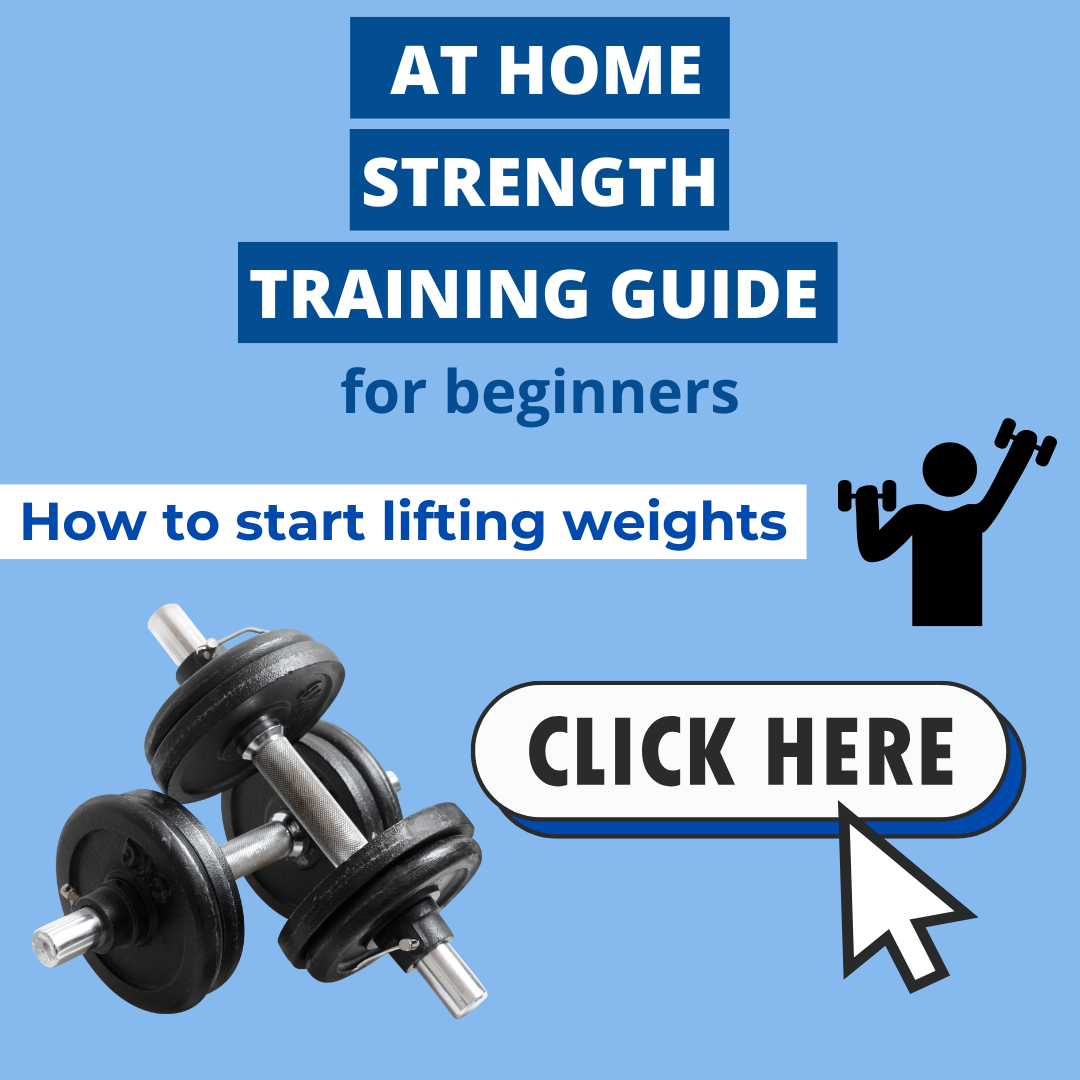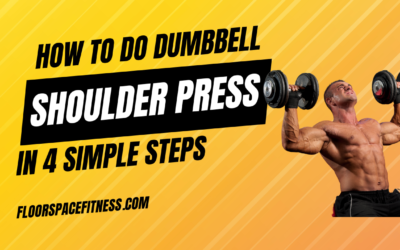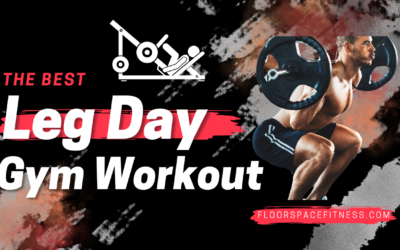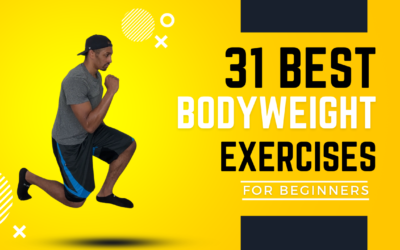How Many Exercises Per Workout Should You Do?

Are you on a mission to lose stubborn body fat and achieve a fitter-looking physique that’s toned and actually has muscle definition?
You’ll need strength training to get there 💪
It’s literally THE ONLY form of exercise that can help you build/preserve muscle mass.
Why is that important?
Well, muscle boosts your metabolism.
And without it you can’t create that toned, more defined physique you want.
Instead, your body will have a softer, pudgier, and not-very-in-shape look to it.
Basically, one of the BIGGEST fat loss mistakes you can make is not lifting weights.
For starters, here’s what strength training isn’t…
It’s not:
- A compilation of random HIIT workouts you saved from Instagram
- Fitness boot camp classes
- Orange Theory
- Burpees
- Kickbacks on the StairMaster with a band wrapped around your legs (read this article I wrote if you want to grow your glutes)
When I say strength training, we’re talking about a structured plan you can follow for the next 8-12 weeks before switching up your workout routine.
And on that program, your main focus should be on getting stronger and applying progressive overload (gradually increasing the amount of weight you lift).
Those are just some of the basics but now you’re probably left wondering…
- How many exercises per workout should I do?
- What’s the ideal number of sets and reps?
- How many days per week should I workout?
Coming up with a workout plan might seem overwhelming but that’s what I’m here to help you with today.
If you want to learn how to create your very own customized strength training routine to build muscle and help you lose fat from scratch, then don’t click away.
I’ll walk you through step-by-step how to determine the number of exercises per workout you should be doing, the sets, the number of reps, and all that good stuff.
How many exercises, sets, and reps should I do?
First off, what are sets and reps?
Before we get into how many exercises per workout, sets, and reps you should do, let’s lay a little groundwork.
If you’re scrolling online, you might see something like this: Perform 3 sets x 5 reps.
What does that even mean?
Let’s start off with the “reps” piece.
Reps = the number of repetitions you perform of an exercise.
So one rep is performing a specific exercise one time.
For example, let’s say you’re trying to increase your bench press.
One rep would be lowering the weight down to your chest and pressing the weight back up.
Two reps would be:
- Lower the weight down to your chest and press up
- Lower the weight down to your chest again and press the weight back up
Three reps would be:
- Lower the weight down, press the weight up
- Lower the weight down, press the weight up
- Lower the weight down, press the weight up
And so on…
A set is just a cluster of reps.
For example, lowering the weight down to your chest and pressing the weight back up five times would be one set.
Once you get done with your set, you would take a rest.
Putting it all together…What would 3 sets x 5 reps look like?
- Complete 5 reps, take a rest
- Complete 5 reps, take a rest
- Complete 5 reps, take a rest
Why do sets and reps matter?
The number of sets/reps you choose should align with your training goals.
Your main objective could be to improve your body composition (i.e. lose fat, build muscle) while someone else might have the goal of building up muscular endurance for a stronger finishing kick at the end of a race.
I will say this though…
A good strength training plan will have a nice variety of sets/reps.
How many reps per exercise is ideal?
In general, here’s how to think about rep ranges as it pertains to your goals:
- Strength: 6-8 reps
- Hypertrophy: 8-12 reps
- Endurance: 10-15 reps
As we go through each one of these goals, don’t think “I only get one.”
You’re not a kid whose parents are only letting them pick out a single toy at the toy store.
As I just mentioned, your strength training workouts should have some diversity in terms of sets and reps.
What are the best sets and reps for strength?
When it comes to lifting for strength, you want to go for 3-5 sets of about 6-8 reps each.
In this rep range, you’ll be lifting the heaviest amount of weight you can.
Why the 6-8 rep range?
Well, in general…
Lifting heavier weight requires a higher intensity, which means you won’t be able to do as many reps.
That’s not to say you shouldn’t be working hard in all rep ranges.
But think about it like this:
A 100 meter sprinter goes all out because they know they don’t have very far to go.
And if they want to go fast, each step requires 100% maximum effort and force.
That’s how you can think about lifting in the 6-8 rep range.
There are three main types of lifts:
- Compound movements: Think exercises like bench press, squat, and deadlift which work multiple muscle groups at once. Since you’re able to work more than one muscle group at a time, compound lifts give you the most bang for your workout buck.
- Accessory movements: These support your compound lifts and include exercises like lat pulldown, seated row, and lunges. FYI, most accessory movements are interchangeable with compound movements, and vice versa.
- Isolation lifts: Think of these movements as the “icing on the cake” of your workouts. Isolation exercises work just one muscle group at a time (i.e. bicep curls, tricep extensions, legs curls, leg extensions).
Lifting in the strength rep range goes with compound lifts.
Make sure you start your workouts out with these when you’re fresh.
They require the most energy, and when you’re lifting heavier weight, form is especially important.
Saving compound lifts until the end of a workout when you’re fatigued is just an injury waiting to happen.
Key takeaway: Choose 1-2 compound exercises per workout and place them at the beginning of your workouts. Perform 3-5 sets of 6-8 reps at a heavy weight.
What are the best sets and reps for hypertrophy?
When you think about building muscle, hypertrophy is probably a word you’ve heard thrown out there.
Yes, hypertrophy can get you bigger muscles.
But to the ladies out there who are thinking to themselves…
“I’m afraid of becoming big and bulky like a man,” fear not.
Hypertrophy won’t transform you into the Incredible She-Hulk.
But what lifting in this rep range can help you with is giving your physique shape and a more toned, defined look.
So… How many exercises per workout, sets, and reps go with hypertrophy?
Stick to around 2-4 sets of 8-12 reps.
When you think about hypertrophy training, I want you to think “moderate weight.”
It shouldn’t be as heavy as with compound lifts.
Since you’re lifting more reps with each set, you want to scale back a little bit on how heavy the weight is.
This rep range falls under your accessory lifts.
Key takeaway: Pick 2-4 auxiliary exercises per workout and put them right after your compound lifts. Perform 2-4 sets of 8-12 reps each using moderate weight.
What are the best sets and reps for muscular endurance?
When someone says they want to tone their muscles, my mind instantly goes to those workout videos.
The ones where everyone has those pink 2.5 pound dumbbells and Debbie, the instructor, is up in the front of the class going: “Camonnnnn, feel the burnnnnn!!”
Am I only an island by myself with this one? 😂
If you’ve read my weight loss truths post then you know that lifting exclusively “lighter weight for reps” isn’t how you “tone” your muscles.
The good news is lifting in the 10-15 rep range with a challenging weight can help you increase muscular endurance and it makes for a more well-rounded workout.
Since your reps are on the higher end, the weight you lift will be on the lower end.
The muscular endurance rep range = isolation lifts.
Key takeaway: Pick 0-3 isolation exercises per workout and put them at the very end of your workouts. Perform 2-3 sets of 10-15 reps each.
Exercises per workout, sets, and reps summary
Here’s the information we just went over all together on how to structure your workouts:
- Choose 1-2 compound lifts to start your workouts with and perform 3-5 sets for 6-8 reps at a heavier weight
- Choose 2-4 accessory movements and perform 2-4 sets for 8-12 reps using moderate weight
- Choose 0-3 isolation lifts to end your workouts with and perform 2-3 sets of 10-15 reps at a lighter weight
Everything we’ve talked about are GUIDELINES.
They’re not hard set rules you have to follow no matter
Workout police aren’t running around like: “Woah woah woah! That’s not the correct rep range for your accessory movements. Turn around and place your hands behind your back, you’re under arrest.” 😂
That would be silly.
How to create your own customized strength training plan: Exercises per workout, sets, and reps
You’re all up to speed on the different types of training to have in your workouts.
Now, it’s time for you to create a personalized strength training plan, complete with the number of exercises per workout you should do, the sets, and the reps.
The first thing to do is…
1. Decide on a workout split
Your workout split tells you what muscles you’re going to train on what days.
This is just my two cents but I would suggest sticking with a 3 or 4-day-a-week workout split.
For example, if you choose to workout 3 days a week, that’d be something like:
- Monday—Lower body
- Wednesday—Upper body
- Friday—Full-body workout
If you want to workout 4 days a week, a good plan to go with is an upper/lower split.
That’s something like:
- Monday—Lower body
- Tuesday—Upper body
- Thursday—Lower body
- Saturday—Upper body
2. Structuring your workouts
Remember…
- 1-2 compound lifts at the very beginning of your workout
- 2-4 auxiliary lifts second
- 0-3 isolation lifts at the very end
Putting all that together, here are a couple of example workouts of what that could look like…
Lower body workout:
- Back squat 3 sets x 6-8 reps
- Hip Thrust 3 sets x 6-8 reps
- RDLs 3 sets x 8-10 reps
- Leg extension 3 sets x 10-12 reps
- Calf raises 3 sets x 12-15 reps
Upper body workout:
- Flat bench press 3 sets x 6-8 reps
- Seated shoulder press 3 sets x 8-10 reps
- Lat pulldown (overhand grip) 3 sets x 8-10 reps
- Seated row 3 sets x 10-12 reps
- Cable tricep push down 2 sets x 10-12 reps
- Bicep curl 2 sets x 10-12 reps
How many exercises per workout FAQs
How do I know when I should increase the weight during my workouts?
Knowing when to increase the weight can be tricky.
You probably just sort of guess at it, adding weight randomly and hoping for the best.
Instead of that, try the double progression method.
It takes all the guesswork out and lets you know exactly when you should be going up in weight.
How should I workout if I want to lose fat?
I know this entire post has been about exercises per workout, sets, reps, and all that.
But don’t get it twisted.
To lose fat, you have to be in a calorie deficit, which means you’re consuming fewer calories than your body burns.
And nutrition (not working out) is the main driver of creating that deficit.
Trying to out-train a bad diet would be like trying to knit a blanket and jump on a trampoline at the same time.
You gonna have any success with that?
I think not.
Is 10 exercises too much for one workout?
Just think of how long it would take to get through 10 different exercises!
Your workouts don’t have to be all lengthy to see results.
If you’re lifting with the right intensity (taking each working set 1-2 reps shy of failure), 10 exercises is for sure way too much.
More isn’t always better, and that’s especially true for working out a lot of the time.

What's up?
I’m Chad, I’m happy you’re here! I’m a certified personal trainer and my goal is to help you form practical, sustainable habits that lead to lifelong fitness results. If you want to lose fat, build muscle, and live a healthier, happier life then you’re right where you need to be. 💪🏾
Free resources
⬇⬇⬇







0 Comments